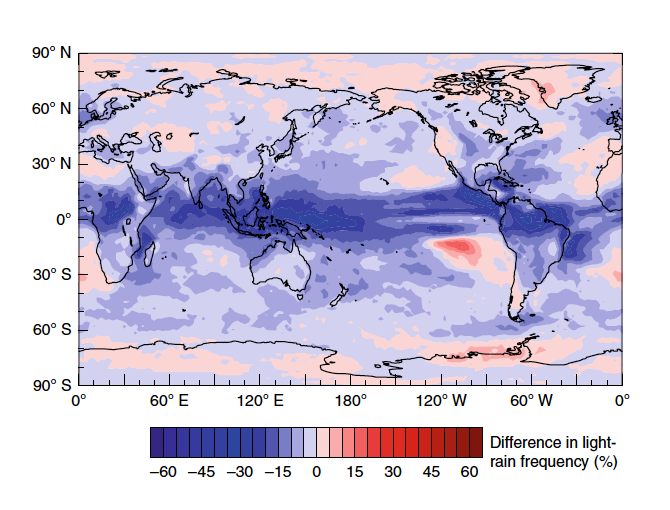Disproportionate Control on Aerosol Burden by Light Rain

Figure 1. Changes of light-rain frequency. Global distribution of differences in light-rain (1 < P < 20 mm d–1) frequency between the CAM5 simulation (without the stochastic convection scheme) and the CAM5 simulation with the stochastic convection scheme (STOC). The image shows STOC minus CAM5.
The Science
Atmospheric aerosols are of great climatic and environmental importance due to their effects on the Earth’s radiative energy balance and air quality. Aerosol concentrations are strongly influenced by rainfall via wet removal. However, global climate models commonly suffer from a well-known problem of ‘too much light rain and too little heavy rain’. The impact of simulated rainfall intensities on aerosol burden at the global scale is still unclear. In a recently published study in Nature Geoscience, researchers showed that rainfall intensity has profound impacts on aerosol burden, and light rain has a disproportionate control on it.

Figure 2. Rainfall & wet removal amount. Amount distributions of total daily rainfall (a) and wet removal of all aerosols (b) by different rainfall intensities over the tropics (20° S – 20° N). Results from Global Precipitation Measurement (GPM), Tropical Rainfall Measuring Mission (TRMM), CAM5 model simulation with the stochastic convection scheme (STOC), and CAM5 without the stochastic convection scheme are denoted by gray, black, red, and blue lines respectively.
The Impact
The implication of the findings in this study is that understanding the nature of aerosol scavenging by rainfall is critical to aerosol–climate interaction and its impact on climate.
Summary
By Implementing the stochastic deep-convection scheme into the Zang-McFarlane (ZM) deterministic deep-convection scheme, scientists improved the representation of convection in the National Center for Atmospheric Research Community Atmosphere Model version 5 (NCAR CAM5) (Figs. 1 and 2) and the US Department of Energy (DOE) Energy Exascale Earth System Model (E3SM) Atmosphere Model version 1 (EAMv1) (Fig. 3). The light-rain (1–20 mm d−1) frequency in these two models was reduced markedly. As a result, the aerosol wet removal was reduced; the aerosol burden was increased globally, especially over the tropics and subtropics, by as much as 0.3 in aerosol optical depth in tropical rain belts. It is attributed to the dominant contribution of light rain to the accumulated wet removal by its frequent occurrence despite its weak intensity.

Figure 3. Occurrence frequency of rainfall as functions of rain rates. Frequency distributions of (a) total, (b) convective and (c) large-scale rainfall intensity over the tropics (20°S – 20°N). Results from Global Precipitation Measurement (GPM), Tropical Rainfall Measuring Mission (TRMM), EAMv1 model simulation with the stochastic convection scheme (EAMv1_STOC) and EAMv1 without the stochastic convection scheme are denoted by gray, black, red and blue lines respectively.
Publication
- Wang, Y., Xia, W., Liu, X. et al. Disproportionate control on aerosol burden by light rain. Nat. Geosci. 14, 72–76 (2021). https://doi.org/10.1038/s41561-020-00675-z
Funding
- The U.S. Department of Energy Office of Science, Biological and Environmental Research supported part of this research (1) as part of the Earth System Model Development Program Area through the Energy Exascale Earth System Model (E3SM) project, and (2) as part of the Regional and Global Model Analysis Program Area (RGMA) and (3) ASR’s Cloud-Associated Parameterizations Testbed (CAPT) project.
Contact
- Guang J. Zhang, Scripps Institution of Oceanography


